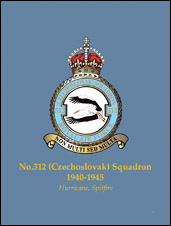This the fifth book of Philippe Listemann’s high-quality series about WW2 RAF Squadrons, is authored by Tomas Polak with Jiri Rajlich and describes in detail the wartime exploits of No. 312 (Czechoslovak) Squadron, RAF
Information presented within its hundred pages provides a comprehensive account of the activities of 312 Squadron, from its formation in August 1940 until disbanding in February 1946. The squadron flew Hurricanes until late 1941 when the changeover to Spitfires was made, with various marks of which it was equipped until after the cessation of hostilities.
The first thirty-five pages cover the operational history of 312 Squadron in depth. 312 Sqdn. was created from a cadre of a score or so experienced Czech pilots, most of which had served with the Czech Air Force and later with the French Armée de l’Air in France 1939-40. Amongst their number was the highly experienced Slovak pilot, Jan Ambrus who had previously been C in C of the Slovak Air Force in 1939- created under the aegis of the Germans after their annexation of Czechoslovakia. Another « expert » was Frantisek Perrina, whose flying skills had impressed French ace J.M. Accart as early as 1937 when the latter had seen him flying in the International Air Competition at Zurich, Switzerland. The selected squadron crest – a stork, was based on the famous « cicogne » insignia carried by GC I/5 & II/5 with which units most of these pilots had previously flown & fought during the Battle of France.
Initially equipped with war-weary Hurricane 1s – 312 entered action in October 1940 in defence of Liverpool and spent the following winter/spring months flying from various bases within 9 Group.. Five years later Spitfire IXs carrying the squadron stork crest would land at Prague-Ruzyne airfield. The squadron’s activities during the interim war years flying a succession of Ramrods, Circuses, Roadsteads, Rhubarbs and Noballs over France and the Low-Countries are fully disclosed. Every airfield where 312 Squadron was located between these key dates, is listed on page 43. The Czechs of 312 Sqdn. served under every UK Fighter Group during the war. All operations flown from these locations are described, chronologically, according to the various wings under which 312 flew. The Kenley Wing period 1941 is followed by the Czechoslovak Wing 1942-43 period (including ops in support of the Dieppe landings), 2nd TAF affiliation is presented comprehensively- breaking down into periods covering the Liberation of Europe, ADGB, Market Garden and seeing the end of the war out at Manston – with post-war winding down and transfer back to Czechoslovakia to form the basis of the Czech 2nd Air Division
Six pages presenting relevant squadron data follow; the crest, the code, all squadron commanders, operational totals, pilots lost, first and last missions flown, awards won, sample codes & serials of aircraft flown, etc., are presented clearly and with good explanatory maps & graphics.
The Operational Diary is encompassed on pages 44-49. All dates with total daily ops flown and monthly totals from October 1940 through to April 1945. The 22.5 a/c claimed by 312 Squadron are individually listed on the following two pages, followed by pages detailing; the 34 Squadron aircraft lost on ops; the 13 a/c lost in accidents; the 17 aircrew of the Roll of Honour and 6 Ps.O.W.
The final fifty pages – the bulk of this book, present by means of abbreviated biographies, all of the pilots who flew with 312 Squadron. Hats off to the authors – here « be » treasure! The roster introduces to the reader 143 pilots who flew with 312 Squadron. With the exception of a handful of British – they are all of Czech & Slovak origin. What quickly becomes obvious is that most of these men were very experienced pilots before they reached Great Britain. The majority of them had flown for several years in their native country – and had then seen combat in France. Many of the personal histories presented – reflect the terrible fate of the central European nations between the rise of Hitler to the demise of the Soviet Union six decades later. This little book thus also serves to « prod » recognition of the sacrifices made by those smaller nations in a war, the outcome of which was not to their benefit. The faces which stare out at us from this section of the book – remind rea ders that fighting for freedom does not guarantee winning it. Their sacrifice must be valued & recalled by those of us who have benefited thereof. Post-war, many pilots would be imprisoned in their homeland – others would choose, 10 years after Hitler’s annexation – to flee abroad once more.
11 excellent colour profiles (4 Hurricanes, 7 Spitfires) present the full variety of aeroplanes flown by 312 Squadron. The colour profiles in this series of books are excellent; the artist (Malcolm Laird) still thankfully includes old-fashioned ‘black lines’ to delineate panels and surfaces. Fussy modellers might care to establish from some of the pan-chromatic photographs (e.g. pages 17, 30, 57) if the small Czech roundel beneath the cockpit was always painted with blue to the front?
Gremlins? The Czech & French authorship of the book – with its gob-smacking excellent English text denies the little gremlins hardly any purchase there – so they’ve done their mischief elsewhere. The reviewer is still searching for an Avro Anson in the photograph on page 4, and wonders why the squadron took four years to hang up the trophy displayed on page 51…
Graham Warrener
96 pages, 17 x 24,5 cm, softcover
Czech it out, buy it & read it ! výborný !
– En anglais / In English



